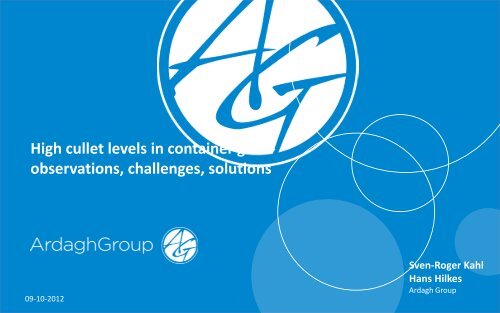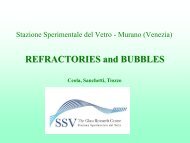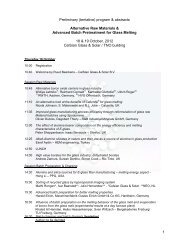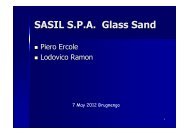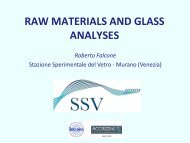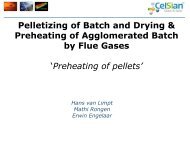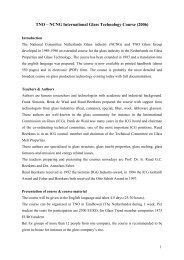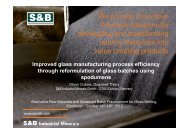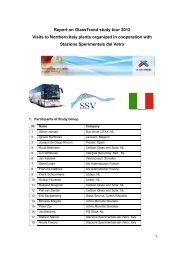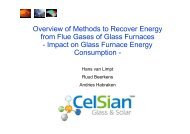High Cullet Levels In container glass - GlassTrend
High Cullet Levels In container glass - GlassTrend
High Cullet Levels In container glass - GlassTrend
You also want an ePaper? Increase the reach of your titles
YUMPU automatically turns print PDFs into web optimized ePapers that Google loves.
<strong>High</strong> cullet levels in <strong>container</strong> <strong>glass</strong>observations,<br />
challenges, solutions<br />
09-10-2012<br />
Sven-Roger Kahl<br />
Hans Hilkes<br />
Ardagh Group<br />
© Ardagh Group 2012
Overview<br />
> Use of recycled cullet in <strong>container</strong> <strong>glass</strong> – a<br />
success story.<br />
> <strong>Cullet</strong> levels in <strong>container</strong> <strong>glass</strong> – where are we?<br />
> Classic contamination: CSP and metal<br />
> Organic contamination and redox – problems<br />
and solutions<br />
> “New“ contaminations: Glass ceramics, lead<br />
<strong>glass</strong><br />
> Where to go in the future?<br />
© Ardagh Group 2012 2
<strong>Cullet</strong> recycling in <strong>container</strong> <strong>glass</strong> – a<br />
success story.<br />
• <strong>Cullet</strong> is used more and<br />
more in all of Europe<br />
• Since 2002 the EU<br />
target of 60% recycling<br />
is achieved<br />
• Until 100% is reached<br />
there is still a huge<br />
potential to save<br />
material and energy<br />
Source: FEVE statistics<br />
© Ardagh Group 2012
Where are we today ?<br />
• Flint <strong>glass</strong>:<br />
• 10…15% for high colour demands (domestic<br />
cullet only)<br />
• 50% for standard colour (40% external cullet)<br />
• 80% is possible (preheater)<br />
• Emerald <strong>glass</strong>:<br />
• 50%...95% depending on availability and quality<br />
demands (lead, inclusion rates)<br />
• Amber:<br />
• 30% … 80% depending on availability<br />
• More and more alternatives are used: plate<br />
cullet, special <strong>glass</strong>es, …<br />
© Ardagh Group 2012 4
What are the main problems?<br />
> Classical contamination: CSP, metal, loose<br />
organics and plastic<br />
> <strong>Cullet</strong>’s influence on redox, based on<br />
contamination and grain size<br />
> “New” contamination: <strong>glass</strong> ceramics, heat<br />
resistant <strong>glass</strong>es<br />
> <strong>In</strong>creasing demands from customers and<br />
authorities result in increasing quality demands<br />
> <strong>In</strong> most EU countries there is a lot of political<br />
influence on the cullet market<br />
© Ardagh Group 2012 5
Classic contamination<br />
Type CSP Metal Loose<br />
organics<br />
Actual limit<br />
for cullet<br />
Detection > 8<br />
mm<br />
Detection < 8<br />
mm<br />
Quality<br />
control<br />
Sticky organics<br />
< 20 ppm < 5 ppm < 200 ppm COD<br />
Good Good Good Not detectable<br />
Reasonable<br />
until 3 mm<br />
Statistical<br />
control<br />
Good Not reliable Not detectable<br />
Statistical<br />
control<br />
Statistical<br />
control<br />
Measurement<br />
of COD, LOI<br />
© Ardagh Group 2012
Quality demands only increase…<br />
© Ardagh Group 2012
Organics, grain size and redox<br />
• Above 60% cullet level redox<br />
is mainly influenced by the<br />
cullet quality<br />
• “Bad” cullet can completely<br />
upset a stable furnace within<br />
hours<br />
• Fine cullet leads to foam and<br />
influences redox as well<br />
Fe 2+ /Fe tot.<br />
Crown<br />
Time<br />
Bottom<br />
© Ardagh Group 2012 8
Problem solutions…<br />
1. If you want to control redox you must measure it<br />
- Optical methods off-line<br />
- Electrochemical methods on-line<br />
2. MPC can smooth the effect of redox on<br />
temperatures<br />
- MPC is the better operator and works as an autopilot<br />
© Ardagh Group 2012
Practical example<br />
> ± 2001: Redox change leads to dropping crown<br />
temperatures and operator reactions – bottom<br />
temperature increases 40K within 3 hours<br />
> ±2002: new instruction – let the crown go, bottom<br />
temperature still increased 25K<br />
> ±2004: online redox sensor in the fore hearth helped<br />
to manage the process, bottom temperature stayed<br />
stable within 10K<br />
> 2010: implementation of MPC – the on line sensor<br />
still showed a redox change, bottom temperature<br />
remains flat<br />
© Ardagh Group 2012
“New” contamination<br />
• Glass-ceramics<br />
• Partly crystallized <strong>glass</strong>es of special composition<br />
• Produced since 1968 in Germany and Japan<br />
• Appearance: transparent, <strong>glass</strong> like, not to be found<br />
by naked eye<br />
• Glass-ceramics do not melt in the furnace but<br />
“follow the process”<br />
• Due to crystal growth the inclusion turns flint<br />
• Main problems are: irregularities with gobs,<br />
blocked spinning nozzles<br />
© Ardagh Group 2012 11
Glass-ceramics – detection techniques<br />
• Since the mid 90ies various techniques became<br />
available<br />
1. X-ray based systems<br />
2. UV-light detection<br />
3. Hyper spectral imaging (under development)<br />
• Techniques 1 and 2 are for the cullet recycling<br />
plant, technique 3 can also be used as on-site<br />
control<br />
• Since 2010 more and more cullet is treated for<br />
<strong>glass</strong>-ceramics and the efficiency is proven<br />
© Ardagh Group 2012 12
Heavy metals (lead)<br />
• Within the EU <strong>glass</strong> packaging may<br />
not contain more than 200 ppm<br />
heavy metals (average over 12<br />
month)<br />
• <strong>In</strong> 32 states of the USA the limit is<br />
lowered to 100 ppm (Soil Protection<br />
Act)<br />
• Recycling cullet in Europe actually<br />
contains about 150…170 ppm lead<br />
• Lead sorting is possible with the same<br />
techniques applied for <strong>glass</strong>ceramics.<br />
• Calculations show that it will take<br />
years to “clean” recycling cullet from<br />
lead <strong>glass</strong><br />
© Ardagh Group 2012
Future solutions<br />
• <strong>Cullet</strong> grinding – the solution for inclusions?<br />
• Grinded cullet (0.8-1.2 mm) is a real solution for<br />
classic CSP inclusions<br />
• Corundum will deliver a total mess of inclusions ±<br />
1mm – be aware of your incoming material<br />
• Grinded cullet gives loads of foam<br />
• Grinded cullet give a lot of carryover and the dust is<br />
literally everywhere in the plant<br />
© Ardagh Group 2012
The “Best Available Future” scenario<br />
• Dry cullet before processing<br />
• Focus on the > 8mm fraction for cleaning from<br />
contamination<br />
• Apply 100% colour sorting, <strong>glass</strong>-ceramics and lead<br />
detection<br />
• Grind the sub 8 mm fraction to 0.8-1.2 mm and<br />
pelletize this cullet.<br />
• Use filter powder (CaSO 4 ) as a free binder, add if<br />
possible other fine fraction (limestone, dolomite)<br />
© Ardagh Group 2012 15
© Ardagh Group 2012


